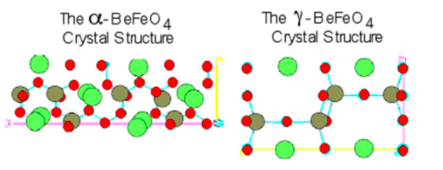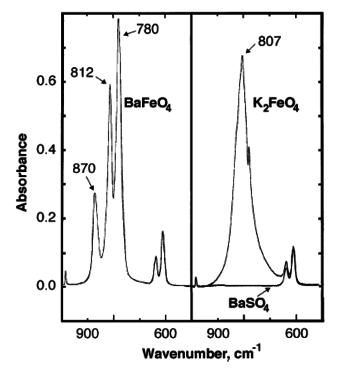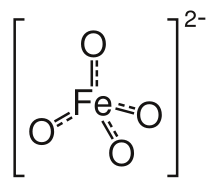Barium ferrate
| | |||
| |||
| Names | |||
|---|---|---|---|
| IUPAC name
Barium ferrate(VI) | |||
| Other names
Barium ferrate(2-) | |||
| Identifiers | |||
| 13773-23-4 | |||
| 3D model (Jmol) | Interactive image | ||
| |||
| |||
| Properties | |||
| BaFeO4 | |||
| Molar mass | 257.17 g·mol−1 | ||
| Appearance | Dark red, opaque crystals | ||
| insoluble | |||
| Except where otherwise noted, data are given for materials in their standard state (at 25 °C [77 °F], 100 kPa). | |||
| | |||
| Infobox references | |||
Barium ferrate is the chemical compound of formula BaFeO4. This is a rare compound containing iron in the +6 oxidation state.[1] The ferrate (VI) ion has two unpaired electrons, making it paramagnetic.[2] It is isostructural with BaSO4, and contains the tetrahedral [FeO4]2− anion.[3]
Structure
The ferrate(VI) anion is paramagnetic due to its two unpaired electrons and it has a tetrahedral molecular geometry.[2]
X-ray diffraction has been used to determine the orthorhombic unit cell structure[4] (lattice vectors a ≠ b ≠ c, interaxial angles α=β=γ=90°)[5] of nanocrystalline BaFeO4. It has a pnma space group (point group: D2h) with lattice parameters a=0.8880 nm, b=0.5512 nm and c=0.7214 nm.[4] The accuracy of the X-Ray diffraction data has been verified by the lattice fringe intervals from High-Resolution Transmission Electron Microscopy (HRTEM) and cell parameters calculated from Selected Area Diffraction (SAED).[4]

Characterization
Infra-red peaks of barium ferrate are observed at 870, 812, 780 cm−1.[7]

BaFeO4 has a magnetic moment of (3.20 ± 0.09) x Am2 (3.45 ± 0.1BM) with a Weiss constant of -89 K.[9]
Preparation and Chemistry
There are two methods for producing ferrate (VI): dry and wet synthetic methods.
The dry synthetic method is usually performed using a thermal technique.[7] Primary experiments indicate an improvement in the purity of the synthesized barium ferrate by performing the reaction at low temperature in the absence of carbon dioxide and by rapidly filtering and drying the precipitate.[10] Addition of a soluble sodium barium salt to an alkali metal ferrate solution produces a maroon precipitate of barium ferrate, a crystal which has the same structure as barium chromate and has approximately the same solubility.[10]
The wet method employs chemical and electrochemical techniques. Barium ferrate, BaFeO4, can be prepared by adding barium oxide to a mixture NaClO and ferric nitrate at room temperature (29± 1 °C).[11] The precipitate formed can then be filtered and washed with a 1:1 hexane and diethyl ether mixture in order to remove water and other impurities. The following is the reaction for the synthesis of barium ferrate using the wet method:
Ba(OH)2 (aq) → BaO(s) + H2O
NaClO + FeNO3 + BaO(s) → BaFeO4 + NaCl + NO
The reaction for the formation of barium ferrate is vigorous and very strong chlorine odor.[7]
Process of purification
Barium ferrate can be purified by washing with petroleum spirit. Further purification can be done by 3 to 5 washes with 95% ethanol followed by another wash with petroleum spirit. Stirring the reaction and repeating the washing process three times produces a dry precipitate.[7]
Uses
Barium ferrate is an oxidizing agent and is used as an oxidizing reagent in organic syntheses. Its other applications include removal of color, removal of cyanide, killing bacteria and contaminated and waste water treatment.[7]
Salts of ferrate (VI) are energetic cathode materials in “super-iron” batteries. Cathodes containing ferrate (VI) compounds are referred to as “super-iron” cathodes due to their highly oxidized iron basis, multiple electron transfer, and high intrinsic energy. Among all ferrate (IV) salts, barium ferrate sustains unusually facile charge transfer, which is important for the high power domain of alkaline batteries.[8]
Reactions[12]
Barium ferrate is the most stable of the ferrate compounds. The formula, BaFeO4•H2O, was determined by Fremy and H. Rose. It can be prepared in its purest state and has the most definite composition.
Prior to drying, barium ferrate can be easily decomposed by all soluble acids, including carbonic acid. After the salt has been dried once, it does not completely decompose easily.
If carbon dioxide is passed through water on which hydrated barium is suspended, barium ferrate will decompose completely to form barium carbonate, ferric hydroxide and oxygen gas.
Thoroughly dried barium ferrate is decomposed completely by hydrochloric acid, releasing chlorine. The irreversible reaction of digesting barium chromate with a solution of sodium ferrate forms barium ferrate, and the color of the solution is changed from red to yellow due to the sodium chromate that is also formed.
Alkaline sulfates decompose barium ferrate that has not been dried, forming barium sulfate, ferric hydroxide and oxygen gas. Barium ferrate, therefore, appears to be one of the most insoluble salts known.
See also
References
- ↑ Briggs, J. G. R. (2005). Longman A-level course in chemistry (4th ed.). Pearson Education South Asia. p. 536. ISBN 981-4105-08-2.
- 1 2 Wiberg, Egon; Wiberg, Nils; Holleman, Arnold (2001). Inorganic chemistry. Academic Press. pp. 1457–1458. ISBN 0-12-352651-5.
- ↑ Wells, A.F. (1986). Structural inorganic chemistry (5th ed.). Oxford [Oxfordshire]: Clarendon Press. ISBN 0-19-855370-6.
- 1 2 3 Ni, Xiao-Min; Ji, Ming-Rong; Yang, Zhi-Ping; Zheng, Hua-Gui (15 January 2004). "Preparation and structure characterization of nanocrystalline BaFeO4". Journal of Crystal Growth. 261 (1): 82–86. doi:10.1016/j.jcrysgro.2003.09.024. Retrieved 29 April 2016.
- ↑ "IUCr". www.iucr.org. Retrieved 2016-04-29.
- ↑ Ropp, Richard C. (2012-12-31). Encyclopedia of the Alkaline Earth Compounds. Newnes. ISBN 9780444595539.
- 1 2 3 4 5 Henry-Chase, Adonica; Tewari, Brij Bhushan (20 September 2013). "Use to Ferrate (VI) A Green Chemical for the Environment Remediation" (PDF). Revista Boliviana de Química. 30 (1): 13–23. ISSN 0250-5460. Retrieved 29 April 2016.
- 1 2 Licht, Stuart; Naschitz, Vera; Wang, Baohui (2002). "Rapid Chemical Synthesis of the barium ferrate super-iron Fe (VI) compound, BaFeO4". Journal of Power Sources (109): 67–70.
- ↑ Audette, R. J.; Quail, J. W. "Potassium, rubidium, cesium, and barium ferrates(VI). Preparations, infrared spectra, and magnetic susceptibilities". Inorganic Chemistry. 11 (8): 1904–1908. doi:10.1021/ic50114a034.
- 1 2 Gump, J. R.; Wagner, W. F.; schreyer, J. M. (1954-12-01). "Preparation and Analysis of Barium Ferrate(VI)". Analytical Chemistry. 26 (12): 1957–1957. doi:10.1021/ac60096a027. ISSN 0003-2700.
- ↑ Herber, Rolfe H.; Johnson, David. "Lattice dynamics and hyperfine interactions in M2FeO4 (M = potassium(1+), rubidium(1+), cesium(1+)) and M'FeO4 (M' = strontium(2+), barium(2+))". Inorganic Chemistry. 18 (10): 2786–2790. doi:10.1021/ic50200a030.
- ↑ Rosell, Claude (1895-01-01). Journal of the American Chemical Society. American Chemical Society. pp. 765–766.

